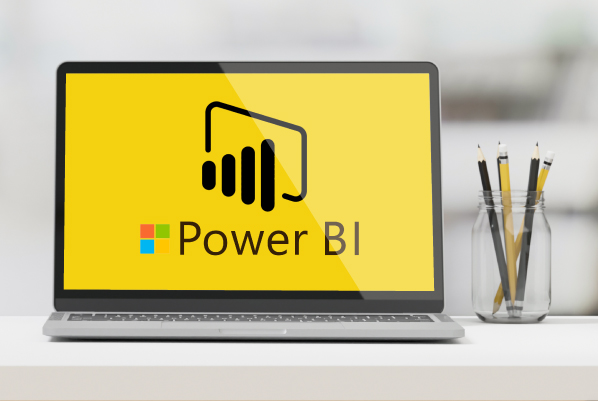POWER PLATFORM | 7 MIN READ
What Is Microsoft Power BI?
Learn about Microsoft Power BI and its data visualization features.

TABLE OF CONTENTS
As the most popular application in Microsoft’s Power Platform suite, Power BI is widely used by organizations in need of advanced data management and visualization capabilities. But is it the best fit for every business?
This guide covers everything you need to know about Power BI, including its features, pricing, and integrations.
What Is Power BI?
Microsoft Power BI is business intelligence and analytics software designed by Microsoft. Initially released in 2011 under the name “Project Crescent,” it has evolved over the years into a powerhouse of data visualization and management.
Power BI acts as a central hub, pulling business data from hundreds of sources so that it can be sorted, studied, and shared. This data can be presented in dashboards and reports, embedded in peripheral software, and rearranged depending on how your business wishes to categorize information collected disparate systems.
Features
The Power Platform is part of the Microsoft ecosystem, an enormous suite of solutions for businesses of all kinds. The Power Platform is a standalone suite under the larger Microsoft umbrella, but certain aspects connect it with other Microsoft systems. For instance, Power BI is a business intelligence tool that is part of the Power Platform, but it is also a built-in component of Microsoft Fabric, a full-scale data analytics solution that exists separately from the Power Platform.
As part of the Microsoft ecosystem, the Power Platform is designed to seamlessly integrate with Microsoft’s other business solutions, such as the Dynamics 365 suite of software for customer relationship management (CRM) and enterprise resource planning (ERP).
Integrations
Power BI is designed to integrate with multiple systems and pull data together for maximum efficiency. Businesses that use Power BI in tandem with other Microsoft solutions can take data management a step further by expanding the ways data is used across the organization.
Dynamics 365
Power BI seamlessly integrates with Microsoft Dynamics 365 applications for customer relationship management (CRM) and enterprise resource planning (ERP) to empower decision-makers and improve data accessibility. This integration does more than bring Dynamics 365 data into Power BI; it enables teams to embed customized dashboards in multiple systems and securely share visual data across the entire organization.
Power BI’s integrations with Dynamics 365 modules offer some unique capabilities depending on which applications are connected. Here are a few examples of what Power BI users can do with integrations to specific Dynamics 365 solutions:
- Dynamics 365 Sales – Build comprehensive dashboards for individual customers, territories, and products to understand and better manage the sales pipeline
- Dynamics 365 Customer Insights – Drill down into campaign, email, website, and social analytics to view cross-channel performance and identify top-performing content
- Dynamics 365 Customer Service – Monitor customer sentiment across multiple channels to identify areas of improvement and sources of customer satisfaction
- Business Central – Design visual reports and interactive dashboards that display real-time finance, sales, operations, and supply chain data; plus, take advantage of the 80+ Power BI reports that come with Business Central that cover all functional areas
Microsoft 365
Power BI reports and dashboards can also be embedded in Microsoft 365 productivity tools. Since Microsoft 365 applications are part of many organizations’ daily workflows, this gives team members easy access to vital business data. Here’s what Power BI can do when paired with some of the most popular Microsoft 365 modules:
- Outlook – View Power BI data sets in Outlook and embed reports and other insights in individual messages
- Excel – Create two-way connections that sync editable Excel workbooks with live Power BI datasets
- Word – Embed charts, tables, and other Power BI visuals within Word documents, such as proposals and contracts
- Teams – Share Power BI reports in chats, meetings, calls, and other Teams channels
- SharePoint – Create centralized dashboards that are accessible to everyone—even team members without Power BI access
Third-Party Applications
Although Power BI is designed to integrate with other solutions from the Microsoft ecosystem, it is also commonly paired with third-party software:
- Sales, marketing, and service software such as Salesforce CRM and HubSpot CRM
- Data gathering tools like SurveyMonkey and JotForm
- Productivity tools like Google Drive and Basecamp
- Ecommerce platforms like Shopify and Stripe
- Web analytics solutions like Google Analytics and LinkedIn Ads
Some popular tools like Gmail, WhatsApp, and Docusign don’t have native or straightforward integrations with Power BI, but it’s still possible to connect the systems via workarounds. APIs and data exports are common means of integrating Power BI with disparate solutions to ensure that users can pull from as many data sources as possible.
Pricing
There is no free version of Power BI; the free version is included with Microsoft Fabric and allows users to create reports with Power BI Desktop. For organizations that need to share and collaborate, Power BI Pro is available at $14 per user per month, while Power BI Premium expands capabilities to include advanced AI, dataflows, and more for $24 per user per month. Larger organizations with hundreds of users can leverage Power BI Embedded, a scalable option with variable pricing based on deployment needs. The table below provides a breakdown of the different Power BI pricing tiers and their key features.
Implementations
Implementing Power BI can take anywhere from a few hours to several months. The timeline is highly dependent on factors like project complexity, data quality and availability, and integration needs. Additionally, training and template customization can add to the overall implementation timeline. It’s best to contact a dedicated Microsoft solutions partner for more information and a reliable estimate.
Power BI vs. Microsoft Fabric
Do Power BI and Microsoft Fabric integrate? Not quite. Power BI and Microsoft Fabric do work together, but they do so differently than Power BI and other Microsoft solutions.
Microsoft Fabric is Microsoft’s data and analytics platform. Like Power BI, Fabric pulls data from multiple sources to create a central hub of business information. However, while Power BI offers data visualization tools for end-users, Microsoft Fabric is focused on processing and managing data. Presentation is part of data management, but it is just one piece of the puzzle. That’s why Power BI is bundled with Microsoft Fabric—because it enables teams to display the data once it has been sorted and categorized.
Power BI users can access select Microsoft Fabric features within an existing Power BI workspace, but most features are locked behind a subscription to Microsoft Fabric.
Why Companies Choose Power BI
According to 6sense, more than 100,000 companies currently use Power BI to manage, visualize, and analyze business data. Hundreds of business users have reviewed the software on sites like G2, Gartner, and SoftwareReviews, with Power BI averaging 4.5 out of 5 stars.
Power BI customers range from small and mid-sized businesses to enterprise-level organizations, with business types encompassing a range of industries such as finance and manufacturing. Despite these diverse backgrounds, users agree that Power BI is intuitive, scalable, and offers powerful integrative capabilities within the Microsoft ecosystem and beyond. Some user reviews highlight Power BI’s low-code and no-code capabilities—while other business intelligence tools require technical expertise to build out integrations to feed charts and dashboards, Power BI empowers every team member to create powerful data displays.
Power BI has also earned awards and recognition for its advanced capabilities. The software is considered a high-ranking leader on lists such as the 2025 Gartner Magic Quadrant for Analytics and Business Intelligence Platforms.
Is Power BI Right for Your Business?
Power BI is a robust business intelligence and data visualization tool, but it’s not the only one available. So how do you know if it’s a good fit for your business? Review the following questions; if you answer “yes” to one or more, then Power BI might be a smart choice for your company:
- Are you a growing mid-sized or enterprise-level company?
- Do you struggle to gather, analyze, and share data across your business?
- Have you heavily invested in Microsoft solutions?
- Is data security a top concern at your company?
- Are other business intelligence tools too code-heavy for your team?
- Is your business data spread out across multiple disparate systems?
Get Started with Power BI
If you’re interested in learning more about Power BI, the Power Platform, or other Microsoft solutions—as well as how much they’ll cost and how they might fit into your existing tech stack—you can reach out to a Microsoft solutions partner like Cargas.
Cargas is one of the largest and most experienced Microsoft partners in Pennsylvania. For nearly three decades, we’ve helped organizations of all sizes and industry types implement Microsoft solutions. If you’re looking for a partner to assess your needs and help you understand what Power BI has to offer, we’re here to help. Whether you’re an existing user in need of Power BI training or you’re just shopping around for a data visualization tool, reach out to Cargas today.

Let’s Chat
Still have questions? Get in touch with our expert team of software professionals.

